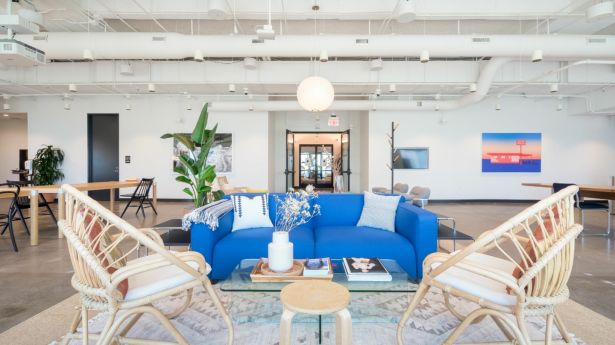Presented By: Partner Insights
Q&A: Upflex & WeWork CEOs Talk Flex Space, Proptech and the Future of Work
Future Of Workplace Innovation brought to you by Upflex
By Christophe Garnier, CEO, Upflex November 16, 2022 9:00 am
reprints
With every passing month, the flexible workplace becomes more prevalent, and more of a constant, for startups and enterprises alike.
Upflex has been providing flexible and hybrid work solutions since 2018, and in 2020, when corporate interest in flexible and hybrid solutions began to surge, we needed to scale up our ability to meet the demand. We multiplied the size of our team, we added new features and solutions to our offerings, and in February of this year, we launched a strategic partnership with WeWork, bringing our technology and our global flex workspace network of thousands of spaces together with hundreds of WeWork’s leased and owned spaces.
These past nine months, WeWork CEO Sandeep Mathrani and I have seen this partnership prove beneficial for stakeholders across commercial real estate. It is benefitting occupiers who want to give employees a broader range of workspace options — especially those who already have team members using WeWork. And it’s benefitting landlords and CRE professionals, who have more to offer to forward-thinking corporate occupiers as they innovate to meet the workforce’s resounding demand for flexibility. For the brokerages that are white-labeling Upflex’s technology and space network, having WeWork’s beautiful spaces on offer makes these options all the more compelling to employers and talent.
Surveys of both workers’ priorities and corporate leaders’ plans indicate that flexible work is here to stay, and like me, Mathrani is a big believer in the idea that collaboration is essential to making the flexible workplace truly manageable, sustainable and efficient. That’s part of the reason WeWork joined CRE giants Cushman & Wakefield and Newmark in Upflex’s last fundraising round, leading our $30 million Series A raise. They have been great partners to Upflex as we work together to help make workplace flexibility more seamless and sustainable for occupiers, brokers and landlords.
In advance of WeWork’s recent, exciting earnings report, Mathrani and I found a few minutes to catch up about WeWork, too, and what he sees for the future of work at large.

Partnering to give occupiers, landlords and brokers more flexibility, more options
CHRISTOPHE GARNIER: With our partnership, Upflex became the only proptech platform that can offer our users access to our 7,000-space network in 80 countries, including WeWork. And WeWork’s been able to do the same, broadening access for your members. This allows WeWork to, in addition to leasing and owning real estate, also hone your focus on being “asset-light.”
When WeWork began looking at a partnership with an asset-light marketplace like Upflex, what was the original challenge you were trying to solve?
SANDEEP MATHRANI: At WeWork, we are always looking for ways to enhance the flexibility and optionality we provide to our members. As companies of all sizes adapt to new hybrid work models, we continue to hear from our members that providing employees with choice and flexibility in how and where they work is a top priority. While WeWork’s global portfolio spans across 33 countries, we recognize the value of being able to offer our members additional access to flexible space solutions in markets where WeWork may not currently operate or have a physical presence.
“As companies of all sizes adapt to new hybrid
work models, we continue to hear from our members
that providing employees with choice and flexibility
in how and where they work is a top priority.”
Our partnership with Upflex enables WeWork to offer our members more solutions and more options beyond our own portfolio. In turn, we are able to offer the vast network of Upflex users access to WeWork spaces as well, expanding our flexible space network.
In the future, we believe this partnership will serve as a playbook for creating a more innovative and collaborative flexible space ecosystem that better serves global and evolving workforces.
GARNIER: Exactly — that’s the kind of ecosystem we want to see. How does this kind of partnership play into your long-term vision for WeWork as a company?
MATHRANI: With the integration of Upflex’s network, WeWork will be expanding its accessible location from 700 buildings to over 7,000 buildings, all of which will be available to book through one single platform. Partnering with a tech-enabled aggregator platform like Upflex provides our members with a more seamless booking, billing, and member experience, feeding into our long-term goal of using smart technology enhancements to enhance our core product — flexible space — while providing our members with the data and insights to know it’s working.
When we launched our All Access and On Demand products during the pandemic, we digitized our existing portfolio to expand our offerings in a new way with minimal associated costs. We see continued promise in partnerships like Upflex, which allow us to enhance our core product, improve our member experience and expand our footprint without the traditional upfront expenses associated with new locations.
Serving the workforce’s need for a “third place”
GARNIER: Right. So, looking at the trends WeWork is seeing among the companies you serve now, how is this new digitized portfolio helping them future-proof their workspace strategies? And on that note, how are the perceived advantages of dedicated desks and private offices measuring up to those of on-demand space?
MATHRANI: While on-demand space and dedicated spaces both offer distinctive advantages, they both have flexibility at the core of their value proposition. Our Access products – including our monthly subscription-based All Access and our pay-as-you-go On Demand – meet the needs of workers looking for a “third place.”
This drop-in style workspace gives workers who may not want to go into their official office but are looking for a place to work on an ad-hoc basis an opportunity to access workspace on their own time — and on their own terms.
Our dedicated space solutions also provide our members with flexibility, but in a slightly different way. With dedicated space, companies find that the ability to flex up or down with their space as they grow is invaluable.
“This drop-in style workspace gives workers who may not
want to go into their official office but are looking for a
place to work on an ad-hoc basis an opportunity to
access workspace on their own time —
and on their own terms.”
Most companies aren’t planning for 10 years out, yet the traditional office model locks companies into space for 10 to 15 years, leaving little room to adjust to their evolving needs. This particularly rings true as companies grow and the portability of cost with WeWork adds even more value.
With a global portfolio of buildings, we are able to take a member’s contract for space in one market and seamlessly reallocate that spend to space in another market. This makes WeWork attractive in our current world of distributed work, as organizations look to decentralize headquarters or implement hub-and-spoke models in new markets.
GARNIER: Of course we’re seeing that same interest in decentralized headquarters and hub-and-spoke markets. So, after all the changes brought about by the pandemic, what is your read on enterprise companies’ biggest demands now, in the shift to hybrid?
MATHRANI: As the pandemic progressed, we saw certain workplace trends emerging – among both our enterprise and small-medium business members. People grew tired of their makeshift work-from-home setups and were looking for a place to go to break up the monotony of working from home, but still valued the level of flexibility they had grown accustomed to.
In a post-pandemic world, we are seeing increased demand for space that is geared towards collaboration, brainstorming and bringing people together rather than heads-down work. Our in-house design team used this real-time feedback to adjust the layouts of the space to incorporate concepts like collaboration hubs, which foster a more intentional workplace experience through activity-based layouts.
GARNIER: Amazing takeaway: that bringing collaboration and company culture to hybrid is the big priority. Any examples you can share on that front?
MATHRANI: We’ve been working with a variety of companies across industries like tech, such as Revolut and Dropbox, to provide customized space solutions that can shift as business needs change and teams grow. For example, last year Revolut adopted permanent flexible working for its 2,000-plus employees but was still looking to maintain a connected and synergetic workforce. They partnered with WeWork to create touch-down office space called “RevLabs” which incorporated shifting to flexible, collaborative spaces across WeWork locations in Berlin, Dallas, Dublin, Melbourne, Moscow, Singapore and New York.
Similarly, when Dropbox was looking to adjust its office space to reflect how its workforce would want to work when returning to the office, we partnered with the company to power its new workplace strategy and create “Studios” in noncore markets that foster in-person teamwork and culture, supplemented by All Access passes for those who do not live near an HQ or Studio.

Looking ahead — the future of WeWork
GARNIER: It’s been a long two and a half years for the world of work — some tremendous change in the way we all operate and see the world. So looking into the future, say, five years from now, what’s your vision for the company?
MATHRANI: My long-term vision for WeWork centers around enhancing our ability to provide members with the full spectrum of workplace flexibility at scale. As we look to the future success of the company, we see WeWork using strategic opportunities, like our partnership with Upflex, to continually improve on the experiences of our members and continue to position us as a leader in the flexible space industry.
GARNIER: What do you see as WeWork’s biggest advantage in reaching these goals?
MATHRANI: I’ve always said people make a place — and the success of WeWork’s efforts would not be possible without the hard work, dedication and resilience of WeWork employees. I truly believe the magic of WeWork lies within its people, and I am confident they will be our biggest advantage to reaching our goals, both in the short and long term.
GARNIER: I love that: “People make a place.” We are hard at work now helping enterprises around the world improve work/life balance by giving their people the flexibility and choice they want. Thanks for taking the time, and we’re looking forward to seeing what’s ahead in 2023.
Interested in learning more? Connect with a workspace solutions advisor to learn more about customizable solutions for flex and hybrid work.
For more articles on the future of workplace innovation click here


